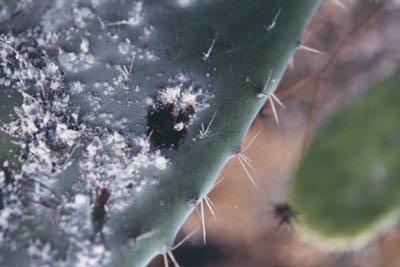Agriculture
That any agriculture exists at all on Lanzarote is an enormous tribute to the inventiveness and gutsy determination of the islanders themselves. With rain so rare and underground water facilities extremely limited, it really does seem miraculous how any agriculture can exist at all on Lanzarote. But viticulture and agriculture do exist, through the daily miracle of crops sprouting from the picon, the black volcanic grit found in abundance on the island.
According to the Agricultural Training Board of the Canary Islands, Lanzarote receives less rainfall than parts of the Sahara, with a mere 14 centimetres of precipitation per year. Lanzarotes farmers are still inthe process of developing agricultural techniques. Only 15 years ago the majority of the farmers used camels to pull their ploughs. Now that figure has dropped to about five percent.
Its now, in fact,probably cheaper to buy a tractor than it is to buy a camel, most of which come from Mauritania on the west African coast. The disadvantage with a tractor however is that it tends to squash the picon and can make life even more difficult .Camels, however, are mainly reserved for the tourists now apart from a few hardy peasant farmers who refuse to give up their old traditional ways.
Onions are the islands chief crop with the majority exported to mainland Spain, although Lanzarote onions also end up on the tables of English, Dutch and German homes. And anyone who has tasted Lanzarote onions will attest to their delicious sweet flavour, less harsh than their counterparts produced on the Spanish mainland.

Lanzarote exports more than three times as many onions as it consumes, although classification and final packing take place on mainland Spain. Red and white potatoes, known locally as batatas or boniatos are also exported, as are a whole range of green vegetables, including the delicious spinach grown here.
One of the popularly held myths is that bananas grow on Lanzarote. Potential banana pickers must, however, head for Tenerife for their sport, where there is less wind and significantly more rain. However, a project exists in the north of the island which is attempting to develop the production of pineapples, already with some success.
The drink Campari, meanwhile, gets its characteristic red colour from cochineal, a dye which is extracted from a species of crushed beetle found extensively on Lanzarote. Thousands of female cochineal beetles are nurtured on the leaves of cacti in Lanzarotes northern villages of Mala and Guatiza. The cacti are expressly grown for the cultivation of the beetles.
The parasitic beetle, which leads a relatively stationary existence, obtains its nutrients from sucking juices from the cactis leaves. The workers in the cactus fields of Mala and Guatiza, many of whom are women, ensure that the insects are spread out among the plants. After two to three months, the insects reach maximum size and are then ready for the harvest.

The harvest is carried out by carefully scraping off the beetles from the cactis leaves with a large spoon--like tool. The gatherers wear thick gloves to protect their hands from painful prickles. The beetles, which look white on the leaves, and endow whole fields with a strange whiteish veil, are dropped into special boxes which both kill them and separate the beetles from unwanted stalks and other impurities.
Farmers then dry the cochineal beetles in the sun before packing them in sacks for export. Being nontoxic, cochineal, the extracted dye, which is also called carmine, is used widely in industry as a colouring for a range of products including lipstick, sweets, toothpaste, and, of course, Campari. The company that produces the bitter red drink, with the sophisticated image, is one of the biggest users of cochineal.